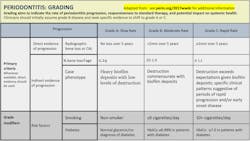When a patient is diagnosed with periodontitis, they should receive a stage and a grade. Stage determines the severity of the condition, while grade determines the rate of disease progression. For grade, you should be asking, “For the patient's age, will they be able to keep their teeth for their lifetime at this rate of bone loss?” One of three grades will be assigned: A—slow rate, B—moderate rate, or C—rapid rate of cynical attachment loss (CAL).
According to Table 1, to determine grade, look at direct progression over five years. If we have the patient's record history and find loss of bone of ≥ 2mm over five years, then the disease is categorized under C. If CAL is < 2mm over five years, it’s in category B, and if there’s no loss over five years, then an A is assigned. If that long-term data is not available, then indirect data will be needed.
Watch more videos from Hygiene Edge
Differences between 11/12 and 15/16 Gracey
Has your IA injection missed the mark? Here's how to get it right
One category of indirect progression is case phenotype. This means the patient’s biofilm and deposit amounts are consistent with their amount of bone loss. For example, if there's a very low amount of biofilm and deposits with a rapid rate of CAL, then you should be very concerned about the longevity of the dentition affected.
The surest way to determine the grade is to do a little math. First, review the radiographs and find the most severe area of bone loss percentage. Then divide that number by the patient's age. If the number is ≤ .24, assign a grade of A, if it’s .25–1.0, assign grade B, and if it’s ≥ 1.1, assign grade C.
For example, if the patient has 30% bone loss and is age 24, divide 30 by 24, which equals 1.25. This would be graded as a C. If we logically think about a 24-year-old with 30% bone loss localized or generalized, there is cause for concern without even doing the calculation.
Finally, two risk factors need to be considered. If a patient has HBa1c numbers from diabetes of ≤ 6.99%, their periodontitis is in the B category. But if the HbA1c is ≥ 7.0, their grade is a C. If a patient reports smoking half a pack per day, which is about nine cigarettes, their periodontitis is graded as B. If they smoke 10 or more cigarettes, they fall into the C category.
Note that if the patient presents in one category as an A and in one as a C, assign the greatest of the categories because the patient should receive only one grade. Want to see this in action? Check out our grading video from Hygiene Edge above. You can also check out our overview of the AAP classifications video here.
Reference
1. Tonetti MS, Greenwell H, Kornman KS. Staging and grading of periodontitis: Framework and proposal of a new classification and case definition. J Periodontol. 2018;89(Suppl 1):S159–S172. https://doi.org/10.1002/JPER.18-0006
Hygiene Edge was created from three dental hygiene educators who love both dentistry and education. With over 40 years of experience both in the education space and the dental field, Melia Lewis, Jessica Atkinson, and Shelley Brown love sharing their knowledge through helpful, short videos online, speaking, and working with amazing companies. You can find more information at Hygiene Edge, on YouTube (youtube.com/hygieneedge), and Instagram (@hygieneedge). Have a question or a tricky area? Let us know! We’d love to help.







